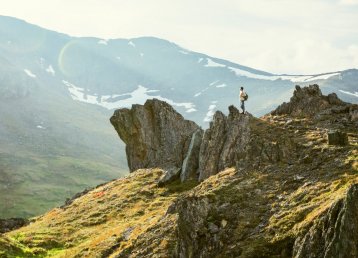A steady, refreshing breeze blows through the forest at Arctic Retreat. Sometimes the wind grabs hold of the trees around the log cabin, where I am staying. The trees sway gently in time with Nature. Every now and then, slight creaking and knocking sounds can be heard. In a time when we have distanced ourselves ever farther from nature, a hotel room in the middle of the woods is a welcome alternative. I gaze out over a bluish twilight landscape and watch the trees dancing gently in the wind. I somehow feel as if I am out there, part of the scene. Outside a welcoming fireplace is waiting, I put my sweater and shoes on, and bring my cup of tea, and step out on the porch. For a little while, I stand still, simply inhaling and exhaling. I run my hand along the stem of a pine tree. It feels familiar, as a part of myself.
Connect with living things
What does it mean to be an animal in human clothing? Author Barbara Kingsolver thought this was a question well worth asking. In an age of artificiality, when modern people are more accustomed to the beep of an airport security check than the sound of Hank Williams’s loan whippoorwill, it is comforting to caress a pine limb and hear birdsong. No wonder the treetop bed trend has grown in popularity. If you ask renowned author and researcher Edward O Wilson for an explanation, the simple answer is biophilia; during our 350 thousand generations here on Earth, we have developed a tendency to connect with other living things. And the meaning of life, according to Wilson, is to find your way of interacting with life – powder skiing, running, foraging or simply being.

The meaning of life
The meaning of life, might be to find a way of interact with life – powder skiing, running, fly fishing, foraging or simply being.
Do wonders
Of course, there’s nothing hocus-pocus about it. It has always been said that a walk in the woods and a breath of fresh air can do wonders for us. But over the past 25 years, a growing body of research has confirmed that this does, in fact, have measurable effects on human physical and mental wellbeing.
In Japan, the practise of forest bathing is well established. In a time when there is a Japanese word for “death by overwork”, karoshi, one possible means of counteracting the effects of the latter is shinrin-yoku – forest bathing. Today some 60 specially designated forest bathing parks in Japan are protected from deforestation, preserved to help people to find tranquillity, harmony and new perspectives.
"The forest has a significant positive effect on our autonomic nervous system"
According to immunologist Qing Li, smelling the fragrance of the forest and breathing in the natural aromatherapy of phytoncides increases our white blood cell count. Another researcher in Japan, Yoshifumi Miyazaki, has shown that the forest has a significant positive effect on our autonomic nervous system. You relax up to 50 per cent better in the forest than in an urban environment, and cortisol (stress hormone) concentrations are markedly reduced. In fact, it isn’t really a matter of raising or lowering stress levels when we are in the forest. It has more to do with reaching a normal level. Quite simply, the human body has evolved for living closer to nature.
Also read
An unbeatable eco-experienceWalk it off
But it isn’t just being in the forest, or forest bathing, that is good for us. Here in Scandinavia, Professor Terry Hartig, at Uppsala University, has demonstrated that being in wide-open spaces, even snow-covered ones, has a positive effect on cognitive function. Professor Hartig has shown that human subjects recover very quickly from fatigue, which is a result of intensive concentration, after a mere half-hour in a natural outdoor setting. Spending 30 minutes of your lunch hour walking in a park or similar relaxing environment can have an extremely positive impact on your physical and mental wellbeing. However, this is not always easily explained or understood.
One of the earliest theories, presented by Kaplan and Kaplan, as to why we feel so well in a natural environment is that this is a simple and undemanding activity. A beautiful landscape fascinates us, and we don’t have to focus on it to be affected by it; instead, we need only immerse ourselves in its restorative qualities. And according to researchers in Germany, among others, Andreas Meyer-Lindenberg in Mannheim, this should be an important consideration for urban planners. For the good of our mental wellbeing, we need more, and perhaps better, restorative green spaces in urban areas.
Also read
Let's go hikingThe academic approach
For decades, academic research has looked at the forest as a source of value, considering it from the point of view of land resources, jobs and economic security. Stanford University in California is just one of many universities that have taken this approach but have in recent years broadened the field of forest research to include human-health aspects of nature and forests.
What researchers at Stanford have found, in agreement with the above, is that loss of contact with nature is directly detrimental to health. Gretchen Daily and her Stanford colleague, Gregory Bratman, have demonstrated that nature has a positive influence on rumination (repetitive thought focused on negative aspects of the self). In their studies, participants who went on a walk through a natural environment, instead of an urban setting, reported markedly lower levels of rumination. Following the old adage “don’t dwell on the negative” seems to be much easier in a natural environment than in an urban one. Both neuroscientific and purely sociological field studies were conducted.
“The world is just discovering how important nature is, while the loss of nature experiences among urban dwellers is enormous. Natural environments are disappearing rapidly”, says Gretchen Daily. “We must take this into consideration when we create the future. Getting out into nature will become essential”, says her colleague Gregory Bratman in the same programme.
Health benefits
When Visit Sweden launched a campaign called “The 72-hour cabin”, a case study was conducted. Several people with extremely stressful jobs – among them a German policewoman, a French taxi driver and a British journalist – were invited to exchange their hectic urban lifestyles for a 72-hour stay in purpose-built cabins in the Swedish countryside. The results were very interesting; in addition to staying in special cabins made of glass and surrounded by nature, the subjects engaged in typical Swedish outdoor recreation activities such as fishing, hiking, swimming in a lake and cooking over an open fire.
The study, conducted by two leading stress researchers from Karolinska Institutet in Stockholm, showed unequivocally that partaking in the nature lifestyle for which Sweden is known alleviated the participants’ stress significantly. Stress levels, heart rate and blood pressure, decreased dramatically during their stay in the woods and their creativity was seen to increase.
"The world is just discovering how important nature is, while the loss of nature experiences among urban dwellers is enormous"
— Gretchen Daily. Professor of Environmental Science at Stanford University.
It’s just natural
Another researcher who has studied the restorative power of the “view to the outside” is Roger Ulrich, Professor of Architecture at Chalmers in Göteborg. In a study published as early as 1984 Ulrich reported that surgical patients who had been exposed to the natural environment, for example, with a view of a park outside the hospital window, recuperated faster than patients whose rooms overlooked a built environment. After one week of recovery, patients with a view of nature used less pain medication and were discharged about one day sooner than those who looked out on a brick wall.
But is all of this really so surprising? Edward O Wilson popularized his biophilia hypothesis in the 1980s. Biophilia, love of life and all that is alive is an innate human tendency, according to Wilson. Over some 350 thousand generations, the hunter-gatherer within us has evolved, genetically, to love nature. There, more than anywhere else, we feel at home – because it is in our genes. Consequently, each of us must find our own affiliation with nature in order to feel better.
Natural good
For some, it is almost meditative; they simply want to be. For others, like skiers, climbers and runners, it is more of a platform for adventure. For foragers, nature is a pantry. The wild berries and fungi they pick taste better than the grocery-store varieties. Whether it is fresh or frozen, you know where the fish and game caught by your own hand comes from. This evening at Arctic Retreat they are serving moose, whitefish and löjrom. Flavours that couldn’t be more local.
If I travel a bit farther inland, to Jokkmokk, I could have a lengthy chat with food entrepreneur Eva Gunnare, who is rediscovering the green kitchen of this Arctic region. We are beginning to understand that something such as bark bread, which once kept northern people alive in times of famine, probably also kept them healthy. Not only wild berries and fungi are edible; more recipes and uses for wild plants, such as angelica, dandelions and euphorbia, are yet to be defined. But rest assured, they will be.
Also read
Get a taste of Swedish LaplandGetting closer
I walk through the woods, running a hand along the trunk of one pine tree after another. According to Qing Li, every time you run your hand along the bark of a tree, substances that benefit the immune system are released. The tree reacts to your touch by releasing an aroma that would fend off an attack by an intruder, such as an insect. That this substance is good for our white blood cells may seem like a happy accident, a divine thought or a benign quirk of evolution. The important thing is to welcome the opportunity to benefit from it.
Pine bark has a slightly resistant texture when you run your hand over it; yet it is satiny, warm and welcoming. It smells of spring, and I am elated. Soothed by the wind that plays among the trees outside the log-cabin, my home for the night. Sleeping in the embrace of the trees, I am as close to the forest as I can get.
SOURCES
Sveriges Televison/SVT, Vetenskapens Värld: “Frisk av naturen”, aired September 1st 2019 and VisitSweden.com, “The 72 hour cabin”.






































